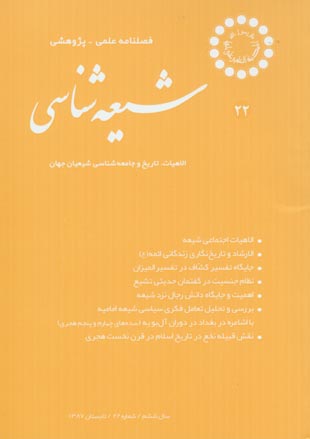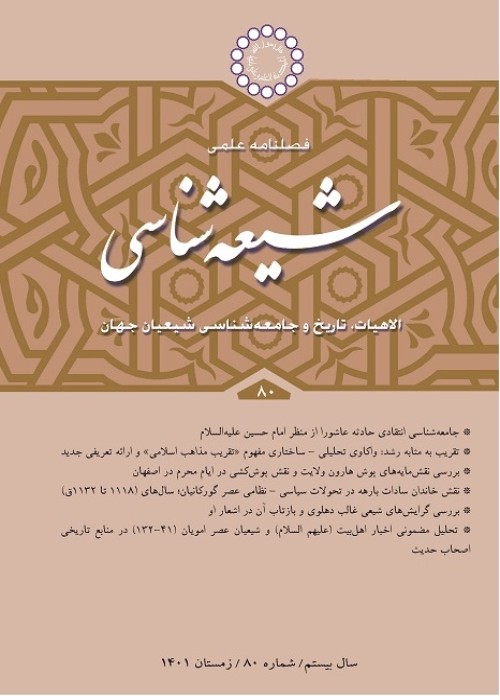فهرست مطالب

فصلنامه شیعه شناسی
پیاپی 22 (تابستان 1387)
- 254 صفحه، بهای روی جلد: 9,500ريال
- تاریخ انتشار: 1387/11/10
- تعداد عناوین: 7
-
-
صفحه 7الاهیات اجتماعی به آن بخش از دانش الاهیات اطلاق می شود که به حیات اجتماعی انسان و عوارض و لوازم و تبعات آن حیات، همچون حکومت، تجارت، تعلیم و تربیت، قضاوت، نکاح و طلاق، و جنگ و صلح می پردازد.
این رشته بین رشته ای، خود از پنج بخش حدیث اجتماعی، تفسیر اجتماعی، فقه اجتماعی، کلام اجتماعی و اخلاق اجتماعی تشکیل می شود. به شاخه های مذکور از آن جهت عنوان الاهیات اطلاق می شود که همه آنها با متون دینی (قرآن مجید و احادیث) سر و کار داشته، هر یک با شیوه ای اختصاصی مدعیات، آموزه ها و احکام دینی را شرح، توضیح و تفریع و توجیه می کنند.
کلیدواژگان: اندیشه اجتماعی، معرفت اجتماعی، الاهیات اجتماعی، فلسفه اجتماع، فقه الاجتماع -
صفحه 37کتاب الارشاد شیخ مفید علی رغم عظمت و جایگاه رفیع خود در تاریخ نگاری تشیع و نیز زندگی نامه نگاری ائمه(علیهم السلام)، کمتر مورد بررسی درون متنی قرار گرفته است; در حالی که به نظر می رسد بررسی ای محتوایی و سندی، بتواند راهگشای بسیاری از ناگشوده ها باشد. در یک بررسی محتوایی می توان در آغاز، پیگیر سبک تاریخ نگاری شیخ و چگونگی ارتباط آن با مبانی کلامی او شد; ضمن آنکه توجه به برخی از کاستی های کتاب، همچنین دقت در تناقضات یا تناقض نماها و کشف موارد مختلفی از گرته برداری های غیر روشمند از منابع مختلف، از موارد دیگری است که لزوم بررسی این گونه کتب را بیشتر آشکار می سازد.
کلیدواژگان: شیخ مفید، الارشاد، بررسی محتوایی، بررسی سندی، منابع تاریخ نگاری، زندگی نامه نگاری ائمه (ع) -
صفحه 77در بررسی یک کتاب تفسیر، علاوه بر دقت در روش ها و گرایش های مفسر آن کتاب و چگونگی استدلال و شیوایی بیان و سلیس بودن کلمات و مستند بودن مطالب، کیفیت بهره گیری از منابع و مآخذ، مسئله ای مهم و حیاتی است. تفسیر کشاف زمخشری یکی از منابع کیفی و کمی مهم تفسیر مرحوم علامه محمدحسین طباطبایی است. علامه در تفسیر المیزان که از جمله کامل ترین تفاسیر شیعه است، مطالب فراوانی از کشاف نقل کرده و در موارد گوناگونی برای تحکیم استدلال های لغوی، بلاغی و... از آن بهره برده است. در این نوشتار، با تطبیق و مقایسه دو تفسیر، به چگونگی نقل المیزان از کشاف به سبک و روش علامه طباطبایی، در کیفیت نقل و بهره گیری از مطالب زمخشری خواهیم پرداخت.
کلیدواژگان: محمدحسین طباطبایی، محمود زمخشری، المیزان، الکشاف، مقایسه، تطبیق -
صفحه 107این مقاله به دنبال توصیف و بازنمایی نظام جنسیت (سکسوالیته) شیعی است و برای این منظور از رویکرد میشل فوکو در کتاب تاریخ جنسیت بهره گرفته و آن را در بستر متون مقدس شیعی به کار برده است. از نظر نویسنده، نظام جنسیت را می توان یک مفهوم دینی تلقی کرد و آن را نظامی گفتمانی دانست که در یک بستر زیست فرهنگ مطرح شده است. برای این تحلیل، قرآن کریم (همراه با تفاسیر ائمه معصومین(علیهم السلام) و علمای شیعی) و کتاب النکاح وسایل الشیعه به عنوان مبنای کار تعیین شدند و از دیگر کتب حدیثی برای تکمیل دامنه نمونه های تحقیق استفاده شد. نتایج این تحقیق، چنین نشان می دهد: 1. نظام جنسیت شیعه، اهمیتی بلامنازع در آیین شیعه دارد; 2. نگاه مثبت شیعه به روابط جنسی، زمینه آشکاری در تشویق این نوع ارتباط غیرکلامی و روش های آن پدید آورده است; 3. در بینش شیعی، تولد انسان نشانه ای از حکمت و قدرت پروردگار است; 4. مذهب شیعه در متون مقدس خود به تعریف الگوها و مرزهای نظام جنسیت پرداخته و استراتژی های گوناگونی را برای محافظت از هر کدام تعیین نموده است.
کلیدواژگان: نظام جنسیت، شیعه، قرآن، وسایل الشیعه -
صفحه 153برای شناخت راویان حدیث، علمی به نام علم رجال سامان یافته که متکفل تبیین حالات و صفات راویان است.
نقش و جایگاه واقعی علم رجال در صورتی آشکار می گردد که بدانیم احادیث در طول عمر پرفراز و نشیب خود با پدیده هایی مانند وضع و تدلیس، تصحیف و تحریف، خطا و نسیان راویان و... روبرو بوده است و از مهم ترین دغدغه های محدثان و فقی هان، احراز صدور روایات از معصوم(علیه السلام) بوده است; لذا یکی از اساسی ترین و منطقی ترین شیوه ها برای مقابله با پدیده های فوق، آشنایی با دانش رجال و مبانی و قواعد آن است.
بسیاری از عالمان و فقی هان، فراگیری این علم را بر دانش پژوهان علوم اسلامی، ضرورتی اجتناب ناپذیر دانستند; گرچه گروه اندکی به نام «اخباریون» تلاش کردند از جایگاه واقعی این علم بکاهند و فراگیری آن را به بهانه صحت تمام روایات کتب حدیثی بهویژه کتب اربعه حدیثی شیعه، بیهوده و اتلاف وقت قلمداد نمایند، ولی به جهت عدم استواری دلایل شان، این تفکر نتوانست چندان دوام بیاورد و علم رجال با تلاش علمی عالمان بزرگ در کنار علوم دیگر اسلامی مسیر کمال را دنبال کرده است.
کلیدواژگان: اصولی، اخباری، کتب اربعه، توثیق اجمالی، وضاعان، اخبار متعارض -
صفحه 177بغداد در دوره آل بویه شاهد تعامل در مفهوم همگرایی و واگرایی (تقابل) امامیه با فرقه های مختلف از جمله اشاعره بود.
تعامل فکری سیاسی مطرح در این مقاله، در مباحث همکاری با سلطان جائر، تقیه، خروج علیه حاکم مسلمان، جنگ با مسلمانان و جهاد می باشد.
فرقه اشاعره در تعامل فکری سیاسی توانست جریان امور را به تدریج به سوی خود جذب کند. این تحول پیامدهایی داشت که مهم ترین آنها عبارت بود از: چالش فراروی فلسفه، رکود اجتهاد، پشتیبانی نظری از خلافت، چالش جدی عقلگرایان، غرور در جایگاه مذهبی و تضعیف حنابله. تفاوت امامیه و اشاعره در تعامل فکری سیاسی در مباحثی مثل دولت و حکومت، پیروی یا عدم پیروی از عقل و انفتاح یا انسداد باب اجتهاد است.
تقابل امامیه و اشاعره پیامدهایی همچون تضعیف آل بویه، اقتداریابی خلافت، زمینه سازی برای جایگزینی حنابله، همراه نمودن خلافت با اندیشه های اشعری به دنبال داشت.
کلیدواژگان: تعامل، همگرایی، واگرایی، تقابل، آل بویه، بغداد، امامیه، اشاعره -
صفحه 215یکی از روش های درک علل وقوع و سرانجام حوادث اثرگذار قرن اول هجری، شناخت نقش روابط قبیله ای حاکم بر مناطق شهری و فضاهای عقیدتی و سیاسی است. از این میان می توان برای نمونه قبیله «نخع» را که شاخه ای از قبیله مشهور مذحج و یمانی است، مورد بررسی قرار داد. این قبیله به دلیل آشنایی با اسلام در زمان حیات نبوی به واسطه امام علی(علیه السلام) و سکونت در عراق و مشارکت در حوادثی که به نوعی با تاریخ تشیع مربوط می شود، مبحث این مقال است.
همچنین این مقاله پژوهشی است در جهت تبیین و توصیف اخبار تاریخی و روایی، با تمرکز بر حوادث اثرگذار در تاریخ اسلام و تشیع در قرن نخست هجری که قبیله نخع در آن حضور فعال و بارزی داشته است.
کلیدواژگان: قبیله نخع، مذحج کوفه، شیعه، صفین، امام علی (ع)
-
Page 7Social theology is a part of theology concerned with various aspects of social life, such as politics, war and peace, law, education, as well as interpersonal relationships like marriage and divorce. It is of multidisciplinary nature and consists of five parts: social hadith, social interpretation of the holy scripts, social jurisprudence (or fiqh), social morality, and social Kalām. They are considered as parts of theology since they are all based on holy scripts (such as the Quran and hadith), but each of them uses its own methodology to explain and justify its propositions and arrive at new conclusions.
-
Page 37Sheikh Mofid's Al-Irshād is an important source in the historiography of the Shia and Shiite Imams. However, it has not been sufficiently examined intra-textually. Content analysis and text analysis of the book my open new horizons for research and scholarship on the subject. Such content analysis may, in the first place, examine the Sheikh's style of historiography and its relation to his theological views. Moreover, some weaknesses of the book such as its contradictions and paradoxes as well as its non-methodological gathering of historical data from various sources can be scrutinized in this way.
-
Page 77In examining a commentary book on the Quran, it is important to consider the method used by the commentator, his doctrinal tendency, reasoning, language and expressiveness, and also to see how the commentary is documented. What is of equal importance is to investigate what sources are referred to and how. The late Mohammad Hossein Tabātabā'i's Al-Mizān is one of the most important Shiite interpretations of the Quran. In his commentary on the Quran, Tabātabā'i has widely referred to Mahmood Zamakhshari's Al-Kashshāf, an important commentary on the Quran, to support his literal and conceptual arguments. In this paper, the author compares the two commentaries on the Quran to explore the method employed by Allama Tabātabā'i for using and referring to Al-Kashshāf.
-
Page 107In this article, the authors examine Shiite views on sexuality, by applying Michel Foucault's approach in his book, the History of Sexuality, to Shiite revered texts, including the Quran (and Shiite Imam's and scholar's commentaries on it), and the Al-Nikah Book of Wassā'il al-Shia. Some other complementary hadith collections were also referred to. The authors argue that sexuality can be considered as a religious concept, which as a part of a discourse is articulated in a life-culture context. It is concluded that: 1) sexuality is of paramount importance in the Shiite faith, 2) the faith has a positive attitude towards sexual relationships and encourages such a non-linguistic relationship, 3) the birth of a human being is regarded as a sign of God's wisdom and power, 4) Shiite religious texts have defined the patterns and limits of legitimate sexuality, and introduced mechanisms to protect them.
-
Page 153As the hadith are susceptible to distortion, perversion and alteration, Islamic scholars have been very much concerned about the authentication of the hadith to ensure that they can rightly be attributed to Imams. Hence, Muslims have developed the historio-biography of the transmitters of the haith, as a distinct discipline, in order to assess the credibility of their narrators. Most Muslim scholars argue that familiarity with the biographies of the narrators is a prerequisite for embarking on Islamic research and scholarship. On the other hand, a minority, that is, Akhbaryyūn, insist that all hadith collections, particularly the Shiite four books are authenticated. So, they believe that there is no need for paying attention to the biographies of the narrators. However, such a weak argument is untenable, and the discipline, beside other Islamic disciplines, has flourished, as it is attracting more and more attention.
-
Page 177The city of Baghdad, under the Buwayhids (the fourth and fifth centuries A.H.), witnessed the exchange of views between the Twelver Shia and various other Muslim schools of thought, including the Asharite school. Such exchanges resulted in either similarity or differences of viewpoints. In this paper, it is explored how the issues of collaborating with an illegitimate ruler, waging a war against a Muslim ruler, war among Muslims and the holy war (or jihad) were discussed among such various schools. The gradual domination of Asharites over other schools led to the demise of rationalism, philosophy and ijtihad within the Muslim community, bolstering the institution of Caliphate, and weakening the Hanbalite school of thought. The Twelver Shia and Asharites had opposing views on the issues of legitimate political and religious leadership, the position of rationality in understanding religion, and the legitimacy of ijtihad. Theoretical differences between the Shia and Asharites resulted in the weakening of the Bwayhids and the Hanbalites, as well as the strengthening of the Caliphs and their support for the Asharites.
-
Page 215A way to understand and explain the events of the first century A.H. is to pay attention to the role played by the Muslim tribes and the relations among them. The Nakha' Yemeni tribe was one of such important tribes, as many of whose members were proselytized by Imam 'Ali during Prophet Mohmmad's lifetime. The tribe was settled in Iraq, and involved in some of the formative events of the Shiite history. This paper is a historical survey of events in the first century Islam insofar as the Nakha' tribe played an important role.


